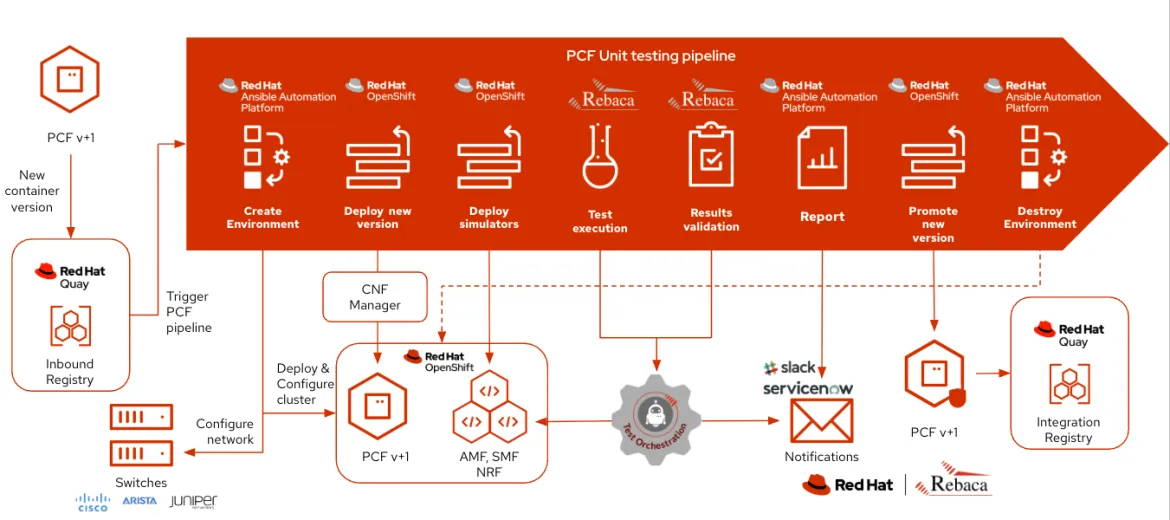In this post:
- Learn about the importance of interoperability testing between the various 5G core network functions.
- Read about the challenges associated with 5G core lifecycle management, software versioning, and its impact on testing and verification.
- Find out how Red Hat and Rebaca’s autonomous continuous testing framework helps service providers with the consistent delivery of compliant and interoperable 5G core cloud-native network functions (CNFs).
The challenge of 5G core interoperability
Deploying a 5G core network involves several key components, including the Access and Mobility Management Function (AMF) for connection and mobility management, the Session Management Function (SMF) for managing user data sessions, the User Plane Function (UPF) for service delivery, the Network Repository Function (NRF) for service discovery, and the Policy Control Function (PCF) for policy enforcement among others.
A significant challenge for telecommunication (telco) service providers is the management of different software versions of these network functions, especially in a multivendor environment. A particular version may include new features, bug fixes, or require specific configurations. Consequently, testing of the network functions is complex, going beyond the verification of each component's functionality to ensure that various versions of these network functions can interoperate. Dealing with this complexity necessitates extensive testing automation to guarantee streamlined operations across the service provider’s network.
Testing within a cloud-native environment
Adopting a cloud-native design for the 5G core gives service providers a competitive edge in building networks that easily scale and adapt. A distributed and disaggregated 5G core network introduces additional challenges, particularly around ensuring that all the different components can work together. As 5G core cloud-native network functions (CNFs) are made up of microservices that are constantly being updated and deployed in a dynamic environment, keeping tabs on security and adherence to standards becomes an overwhelming task.
To ensure that all independently developed components of the 5G core operate effectively, the various network functions within the 5G core must interoperate efficiently, adhering to 3GPP standards. Still, as each 5G core vendor implements their microservices slightly differently, rigorous testing of these interactions is crucial.
Using a comprehensive testing regime
To ensure robustness and performance, the 5G core needs to be tested at different levels:
- Unit testing focuses on specific parts of individual software components (i.e., microservices) within the 5G core network functions (e.g., AMF, SMF). For example, unit testing could examine how the SMF sets up a data connection or how the AMF manages a device moving from one cell to another.
- Integration testing focuses on how different 5G CNFs communicate. For example, integration testing can examine how the AMF requests the SMF to set up a data session when a device connects or how the PCF interacts with the SMF to enforce rules about data usage. Integration testing ensures the elements of the 5G core can exchange information correctly.
- End-to-end testing focuses on testing the overall 5G system. End-to-end testing simulates real-world use cases, such as a phone connecting to a website or making video calls, and ensures the entire 5G system works smoothly to deliver the expected speed and performance for different service types.
Introducing the autonomous continuous testing framework
Red Hat and Rebaca have collaborated to produce an autonomous continuous testing framework to address the challenges outlined with 5G core lifecycle management. The framework is engineered to facilitate the consistent delivery of compliant and interoperable 5G core CNFs.
The framework uses the power of Red Hat OpenShift Pipelines for streamlined workflow automation and Rebaca’s ABot for automated test execution and analysis. OpenShift Pipelines takes care of the heavy lifting by managing the entire lifecycle (continuously integrating and delivering compliant, interoperable CNFs). Rebaca’s microservices-based ABot executes test suites in tranches, analyzes results, and generates reports with insights. This joint solution accelerates testing with OpenShift Pipelines by providing a task-based, application programming interface (API)-first approach aligning with cloud-native principles.
Red Hat Ansible Automation Platform acts as a central orchestrator, directly interacting with Rebaca cloud-native test framework ABot APIs to initiate test executions and facilitates automated and consistent triggering of testing processes.
OpenShift provides real-time visibility of metrics and alerts from ABot and OpenShift Pipelines. If any test result anomalies or critical events are detected by the ABot, OpenShift responds dynamically to issues, triggering necessary remediation or further diagnostic steps without manual intervention. This integrated approach not only automates testing but also builds in the resilience needed for continuous delivery.
Benefits of the automated testing
Red Hat and Rebaca’s autonomous continuous testing framework gives service providers:
- Enhanced 3GPP testing lifecycle and vendor onboarding, automating testing to accelerate integration.
- Improved interoperability and ubiquity of testing. As testing is consistent and automated, service providers gain confidence that different vendor network functions will be fully interoperable. Additionally, sharing and running tests between vendors is simplified.
- Simplified learning curve and reduced tech debt for service providers new to 5G core testing. Red Hat’s and Rebaca’s framework simplifies the process with a user-friendly design that reduces the need to build tests entirely from the ground up. Tests are reusable once written, with service providers simply needing to run the pipeline.
- Hyper-aware automation with robust execution and reconciliation. The power of ABot automation is not just limited to running tests but extends to analyzing the results, pinpointing what went wrong, and providing detailed reports. This means less manual work and faster troubleshooting.
Streamlining functional testing

Testing isn’t just a checkbox for modern software development. It’s a continuous, integrated process. Service providers can streamline functional testing by bringing together different test types into a smooth, automated workflow.
The testing process begins when a container image is pushed to an inbound registry (e.g., Red Hat Quay). This push automatically triggers an OpenShift Pipeline for unit testing by invoking an appropriate ABot API. If those unit tests pass, the image is promoted to an integration registry, where another pipeline runs to verify how components work together.
This layered approach, from unit to integration testing helps identify issues early and ensures each part of the system interoperates. The framework extends this automation to system testing and end-to-end testing, providing a continuous testing lifecycle that reduces manual work, delivers faster feedback, and boosts confidence in every release.
This simplifies test validation and reporting. As soon as a pipeline kicks off, Rebaca ABot runs tests and validates the results automatically, with no manual intervention needed.
Once tests are complete, results are instantly communicated, giving service providers real-time feedback. Whether it’s a quick pass/fail summary or deeper insights, the pipelines keep service provider teams informed and move issues quickly into remediation.
Next steps and how Red Hat can help
For service providers working on 5G core deployments, implementing an automated testing framework isn’t just a nice-to-have. It’s a game-changer. It streamlines vendor onboarding, improves interoperability, reduces technical debt, and delivers automation tailored to real-world needs.
By shifting to a more efficient, automated testing strategy, service provider teams can speed up delivery cycles while ensuring greater stability and scalability across the 5G core. Whether service providers are aiming to fine-tune onboarding processes, or working to ensure smooth integration between network components, an automated framework lays the groundwork for long-term success.
Red Hat and Rebaca’s autonomous continuous testing framework offers benefits including streamlined vendor onboarding, improved interoperability, reduced technical debt, and tailored automation. Implementing our framework speeds up delivery cycles and ensures greater stability, laying the groundwork for long-term success in 5G operations.
In our next blog, we’ll describe how to implement a testing pipeline to bring automated testing to life in a service provider’s 5G workflow.
product trial
Red Hat Learning Subscription | Product Trial
About the authors
Mark Longwell is the Director, Telco and Edge Alliances in the Hybrid Platforms Business unit, with a focus on Telco partners. Mark joined Red Hat in 2016. At Red Hat, Mark focuses on leveraging his extensive Linux partnering experience to work with Red Hat's Global Telco and Edge partners on various go-to-market activities, CNF and VNF Certifications on Red Hat technologies, and technical and sales enablement activities. In his spare time, Mark likes to hike and follow Liverpool Football Club. Mark lives in Boston, MA.
Specialty areas: CNF/VNF Certification, Telco Partnering and Onboarding, global alliances, RAN, ORAN and 5G Core in the Telco market space, and all things alliances and business development related in the Telco space.
Hanen Garcia is Global Telco Solutions Manager at Red Hat, with more than 20 years of experience in the telecommunications industry building network solutions and value-added services for large telecom operators. In his current role, he is driving solutions to support telecommunications service providers during their network transformation journey. Prior to joining Red Hat, he worked at Ericsson as an innovation specialist designing cutting-edge solutions for mobile networks. Garcia holds an M. Eng. in innovation management from the ÉTS in Canada and an M.Eng. in telecommunications from Polytech in France.
As an Associate Specialist Solutions Architect on the Red Hat Tiger Team, Saad helps guide customers through the exciting world of open source. He contribute(s) to shaping Red Hat's strategy and ensuring customers get the most out of our innovative solutions.
Since joining Red Hat in 2022, he has/have primarily focused on designing and implementing robust cloud-native platforms using Red Hat OpenShift. While OpenShift is his core focus for building scalable applications, he also explore(s) how these platforms can cleverly incorporate AI capabilities to unlock new possibilities for businesses. With a Master's degree in Computer Science, he bring(s) a strong technical foundation to every challenge, helping organizations transform their ideas into powerful, real-world solutions.
Rob McManus is a Principal Product Marketing Manager at Red Hat. McManus is an adept member of complex matrix-style teams tasked to define and position telecommunication service provider and partner solutions with a focus on network transformation that includes 5G, vRAN and the evolution to cloud-native network functions (CNFs).
More like this
Browse by channel
Automation
The latest on IT automation for tech, teams, and environments
Artificial intelligence
Updates on the platforms that free customers to run AI workloads anywhere
Open hybrid cloud
Explore how we build a more flexible future with hybrid cloud
Security
The latest on how we reduce risks across environments and technologies
Edge computing
Updates on the platforms that simplify operations at the edge
Infrastructure
The latest on the world’s leading enterprise Linux platform
Applications
Inside our solutions to the toughest application challenges
Virtualization
The future of enterprise virtualization for your workloads on-premise or across clouds



